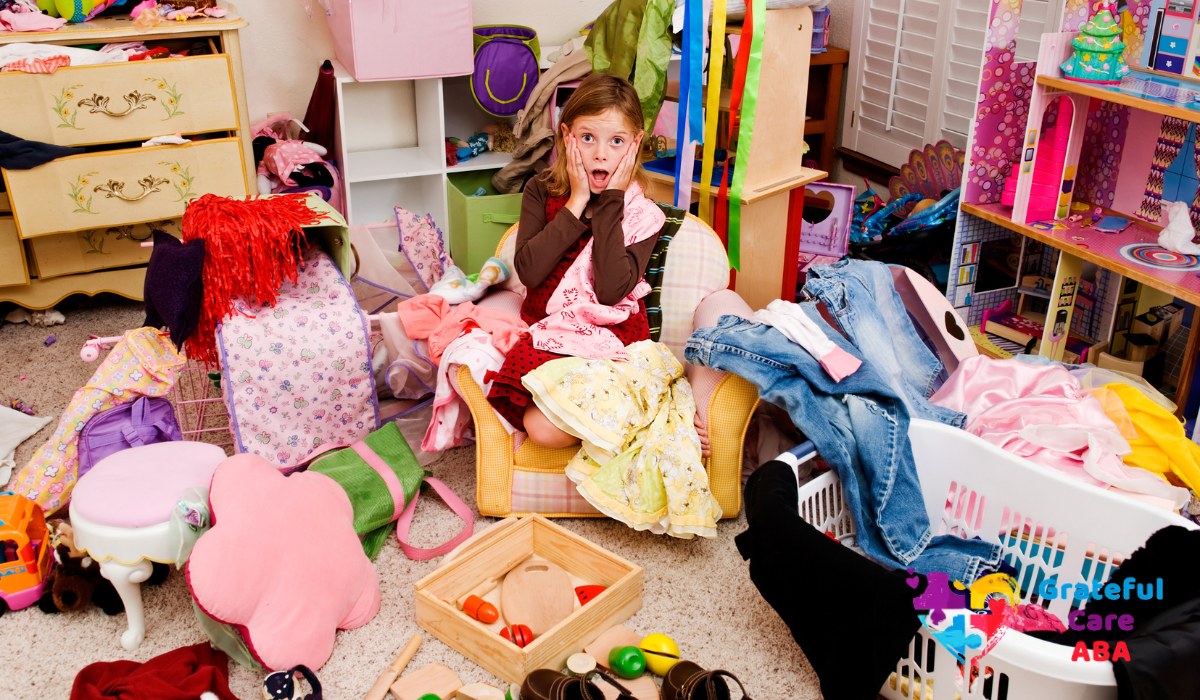Why Executive Dysfunction Happens in Autism
Understand why executive dysfunction happens in autism, how it affects daily life, and tips for supporting organization, focus, and planning.


Key Points:
- Executive dysfunction in autism stems from neurological differences that affect how the brain organizes, plans, and prioritizes tasks.
- It can impact everyday skills—like getting ready for school, completing homework, or transitioning between activities.
- Consistent support, structured routines, and evidence-based interventions like ABA therapy can greatly improve focus and independence.
If your child seems easily distracted, struggles to follow multi-step directions, or melts down when routines change, you may be seeing signs of executive dysfunction. For many individuals on the autism spectrum, it’s not about a lack of motivation or effort—it’s about how their brains manage information and action.
Executive functions are the brain’s control center—skills that allow us to plan, organize, start tasks, shift between them, and monitor progress. In autism, these abilities often develop differently, which can make everyday life feel chaotic or unpredictable.
Understanding why this happens is key to offering meaningful help and compassion.
What Causes Executive Dysfunction in Autism?
Autism involves neurological differences in brain connectivity and information processing. These differences affect how signals travel between regions responsible for attention, working memory, and self-regulation.
1. Brain Structure and Connectivity Differences
Research shows that areas such as the prefrontal cortex—which handles decision-making and goal-setting—may function differently in autistic individuals. These differences can make it harder to switch focus, prioritize tasks, or remember sequences of actions.
For example, a child might understand that they need to brush their teeth before bed, but getting from “knowing” to “doing” can be an overwhelming process if their brain struggles to organize multiple steps.
2. Sensory Processing Challenges
Many autistic people experience sensory sensitivities—to light, sound, textures, or movement. When sensory overload happens, the brain diverts energy away from executive tasks toward calming or protective responses. That’s why even a small disruption, like a buzzing light, can derail focus and planning.
3. Emotional Regulation Differences
Emotional control is closely tied to executive function. When emotions rise, it becomes harder to plan or shift attention. For individuals with autism, emotional regulation systems may react more intensely, leading to shutdowns or meltdowns that further interrupt task management.
4. Working Memory Limitations
Executive function relies heavily on working memory—the ability to hold and manipulate information in real time. In autism, working memory differences can make it difficult to remember multi-step instructions or to stay focused when new information is introduced.

How Executive Dysfunction Affects Daily Life
Executive dysfunction can touch almost every part of daily living. Parents often describe it as “my child can do it, but not when they need to.” The ability is there—it’s the coordination that’s inconsistent.
Below are some common areas where challenges appear, along with what they might look like in real life.
1. Planning and Organization
- Challenge: Difficulty understanding what comes first, next, and last.
- Example: Your child may start a homework assignment but skip crucial steps or forget needed materials.
2. Time Management
- Challenge: Trouble estimating how long tasks will take or keeping track of time.
- Example: They may spend hours on one preferred activity and have no time left for chores or routines.
3. Task Initiation
- Challenge: Knowing what to do but being unable to start.
- Example: Even simple tasks like getting dressed or cleaning up can feel “too big” to begin without prompting.
4. Shifting Attention
- Challenge: Moving from one activity to another without distress.
- Example: Transitioning from screen time to dinner might cause tears or resistance, not out of defiance but difficulty in mental switching.
5. Self-Monitoring
- Challenge: Trouble recognizing mistakes or understanding progress.
- Example: Your child might not realize they skipped a step in an assignment or that they’re repeating a question you already answered.
When these challenges compound, both children and parents can feel frustrated and exhausted. But understanding the root cause opens the door to practical solutions.
Signs of Executive Dysfunction in Children and Teens with Autism
Before diving into support strategies, it helps to recognize specific patterns that signal executive difficulties. Not every child will show all of them, but a combination of these signs often points to underlying executive challenges.
Common indicators:
- Frequent forgetfulness: Homework, materials, or steps in routines are often missed.
- Difficulty with transitions: Changes in plans trigger distress or refusal.
- Procrastination or avoidance: Even familiar tasks seem hard to start.
- Rigid routines: Preferring predictability to compensate for planning difficulties.
- Emotional outbursts: Frustration builds quickly when overwhelmed or confused.
- Poor sense of time: Losing track of how long something takes or when it’s due.
Recognizing these behaviors for what they are—a sign of neurological differences, not disobedience—helps parents respond with empathy and effective tools.
Helping Your Child Manage Executive Dysfunction
There’s no single fix, but there are structured ways to make life smoother. Building support around the brain’s natural strengths, rather than fighting its wiring, can dramatically improve independence and calm.
Here are proven strategies to support executive function at home and school:
1. Simplify and Visualize
Visual tools—like picture schedules, checklists, or timers—help children “see” the sequence of tasks. Instead of remembering steps, they can follow a predictable routine they can touch or point to.
2. Use Consistent Routines
Structure provides comfort. When your child knows what to expect, they don’t have to rely as heavily on internal organization. Keep routines predictable but allow for flexibility when needed, with visual warnings for changes.
3. Break Tasks into Smaller Steps
If “clean your room” feels overwhelming, say “pick up the clothes first.” Each success builds confidence and teaches sequencing. Over time, this breaks large tasks into manageable chunks.
4. Offer Gentle Prompts
Executive dysfunction often requires external reminders. Instead of “Why haven’t you started yet?” try “What’s your first step?” This phrasing encourages thinking rather than pressure.
5. Build Emotional Regulation Skills
Teaching children to name their emotions, use deep breathing, or take sensory breaks strengthens their ability to manage frustration—critical for maintaining focus.
6. Model Organization
Show your child how you plan and prioritize—like writing a grocery list or setting a timer for chores. Seeing it in action normalizes the process.
7. Encourage Self-Monitoring
After tasks, ask reflective questions: “What helped you stay focused?” or “What could we do differently next time?” This builds awareness without criticism.

The Role of ABA Therapy in Supporting Executive Function
Applied Behavior Analysis (ABA) therapy provides structured, evidence-based strategies to help children with autism strengthen skills tied to executive functioning—such as attention, task completion, and adaptability.
Through individualized programs, therapists at Grateful Care ABA focus on:
- Task initiation and follow-through: Using reinforcement to motivate and sustain attention.
- Transition support: Teaching coping tools and predictable signals to move smoothly between activities.
- Problem-solving: Guiding children to break down challenges into smaller steps and rewarding progress.
- Independence building: Helping children rely less on prompts and more on self-regulation skills.
ABA doesn’t just target behaviors—it creates systems that make life more manageable for the entire family. When executive dysfunction improves, daily routines become calmer and children gain confidence in their own abilities.
Practical Tools Parents Can Start Using Today
Even outside therapy, there are simple ways to make home routines easier for children with autism who struggle with executive function. Try integrating one or two of these tools consistently before adding more.
Helpful tools and strategies:
- Visual timers – Help your child see how much time remains for a task.
- Color-coded folders – Use different colors for school subjects or activity zones.
- “First/Then” boards – Clarify expectations (e.g., “First homework, then tablet time”).
- Daily checklists – Encourage self-accountability by checking off completed steps.
- Sensory tools – Fidget toys, weighted lap pads, or movement breaks to maintain focus.
These strategies reinforce predictability and reduce anxiety—two major factors that worsen executive dysfunction.

Supporting Executive Function as Your Child Grows
Executive skills develop over time. What begins as heavy adult support should gradually shift toward independence as your child learns strategies that work for them. Celebrate small wins—like finishing a task without reminders—as major milestones.
Teens, in particular, benefit from learning self-management tools: using planners, setting phone reminders, or creating visual boards for goals. ABA therapy can be adapted at each developmental stage, ensuring support evolves as your child matures.
Building Confidence Through Consistency
While executive dysfunction can make life unpredictable, the right environment transforms potential into progress. With patience, structure, and tailored support, children learn that organization and planning are skills—not barriers.
By working hand in hand with a trusted therapy team like Grateful Care ABA, families can see meaningful growth in focus, time management, and daily independence.
If your child struggles with planning, transitions, or follow-through, we’re here to help. Contact us today to learn how personalized ABA therapy in Tennessee, Indiana, Georgia, North Carolina, Virginia, and Arizona can support your child’s executive function and empower lasting change.
Apply Now
At Grateful Care ABA, we are proud to offer the best ABA therapy services in Indiana. Armed with a team of skilled Board Certified Behavior Analysts (BCBAs), we bring years of experience to the table, making us the preferred provider for ABA therapy in our community.
Understanding that every child with ASD is unique and has unique goals and objectives, our ABA therapists carefully craft personalized ABA therapy plans that are tailored to meet the specific needs of each child. Whether your child needs help with reducing maladaptive behaviors, your child needs IEP support at school, you want your child to be self-sufficient at home, or something else, we use ABA therapy to work diligently toward specific goals. Together we can make a difference in your child’s life!
Contact us today to connect with an ABA therapist and learn more about ABA therapy solutions for your child.

.jpg)
.jpg)




.jpg)
.jpg)
.jpg)

.jpg)
.jpg)
.jpg)
.jpg)
.jpg)
.jpg)
.jpg)


















































































